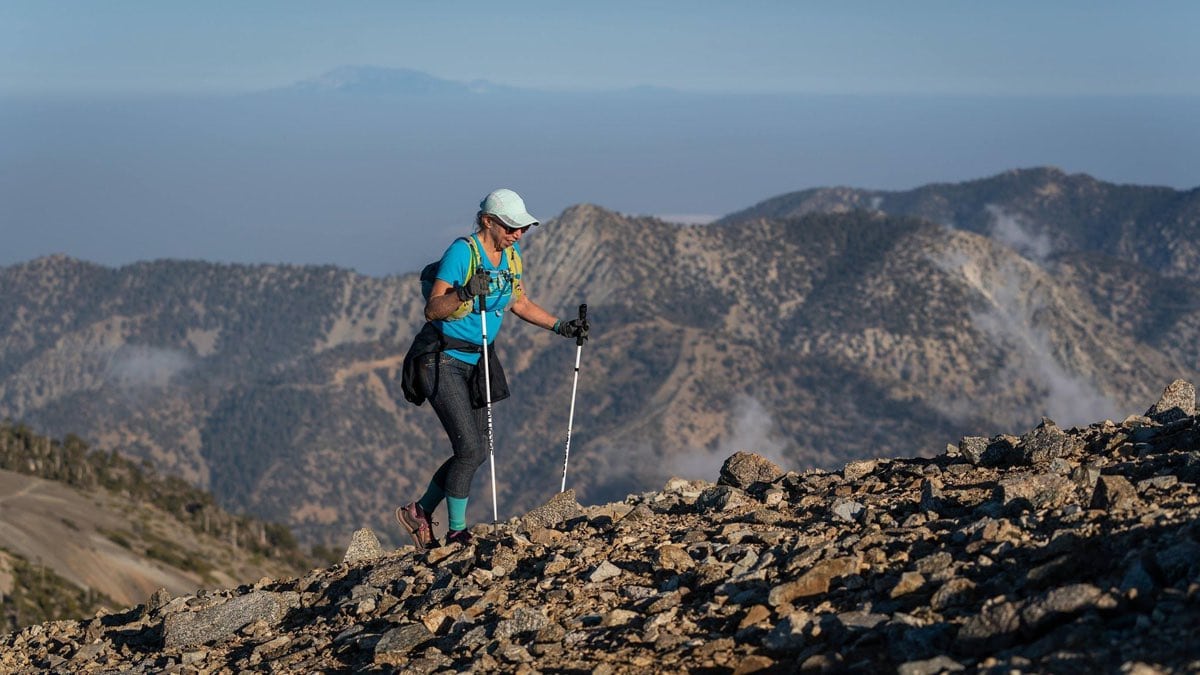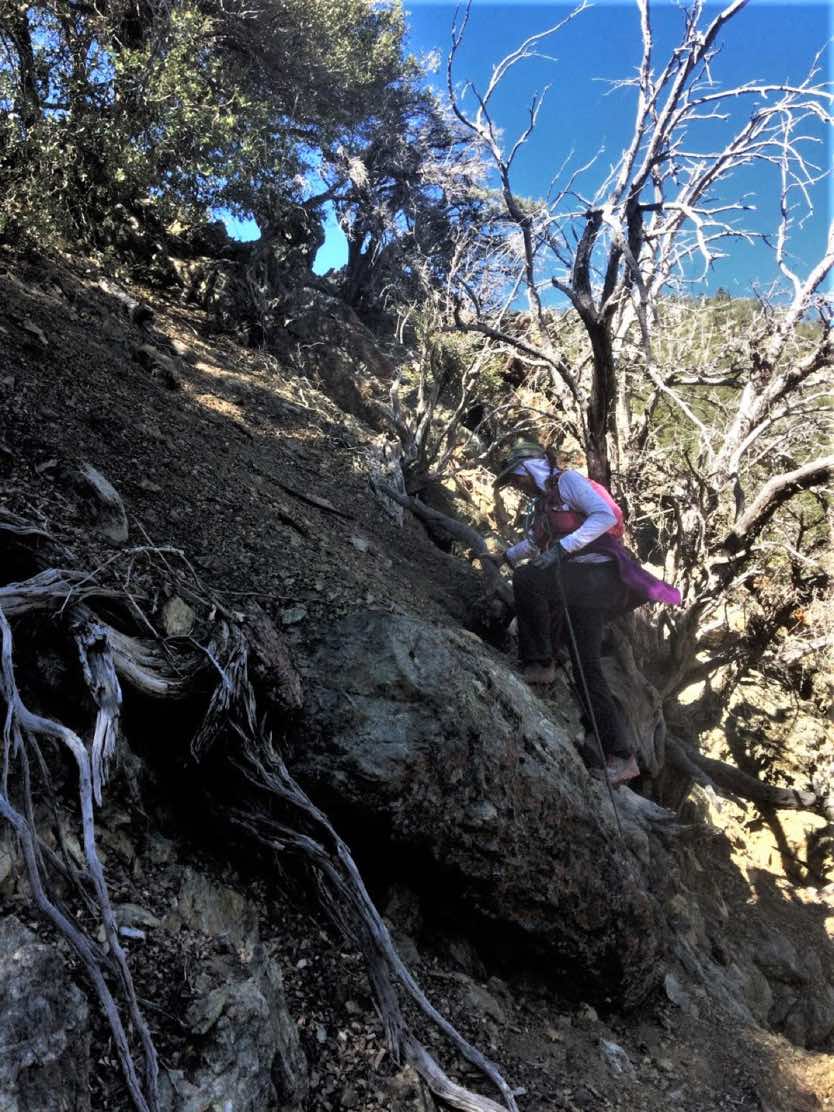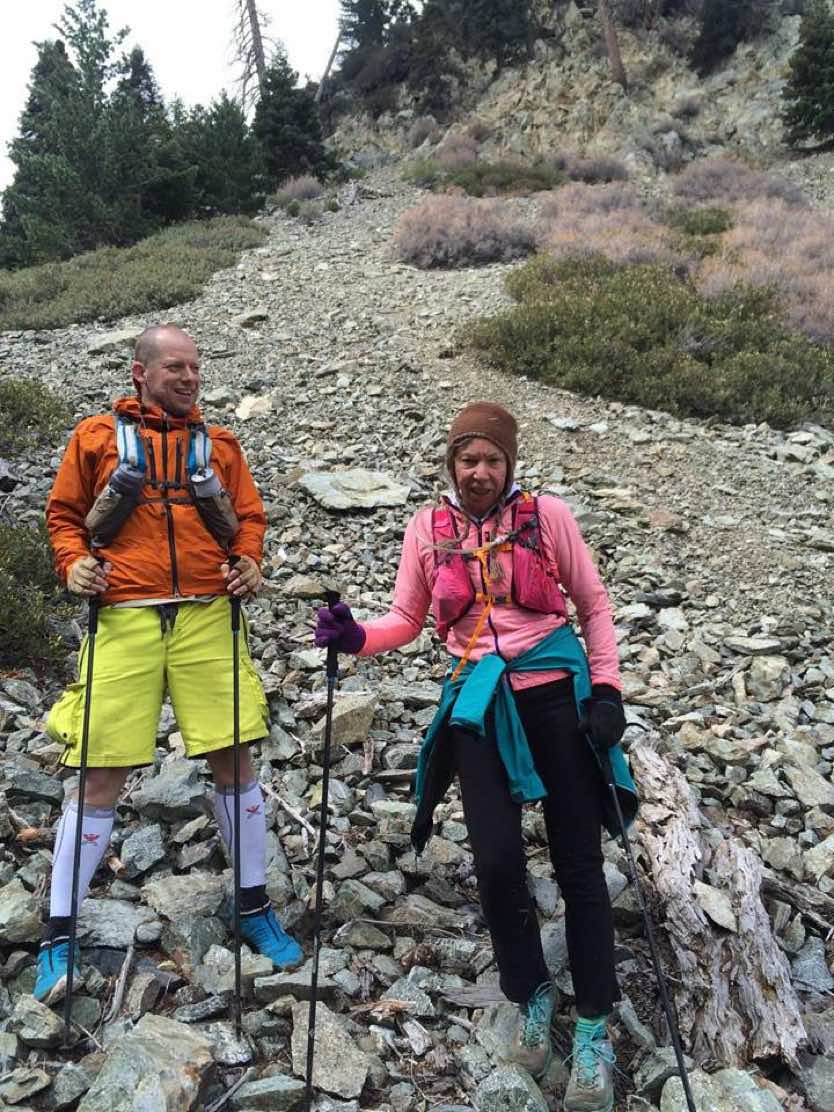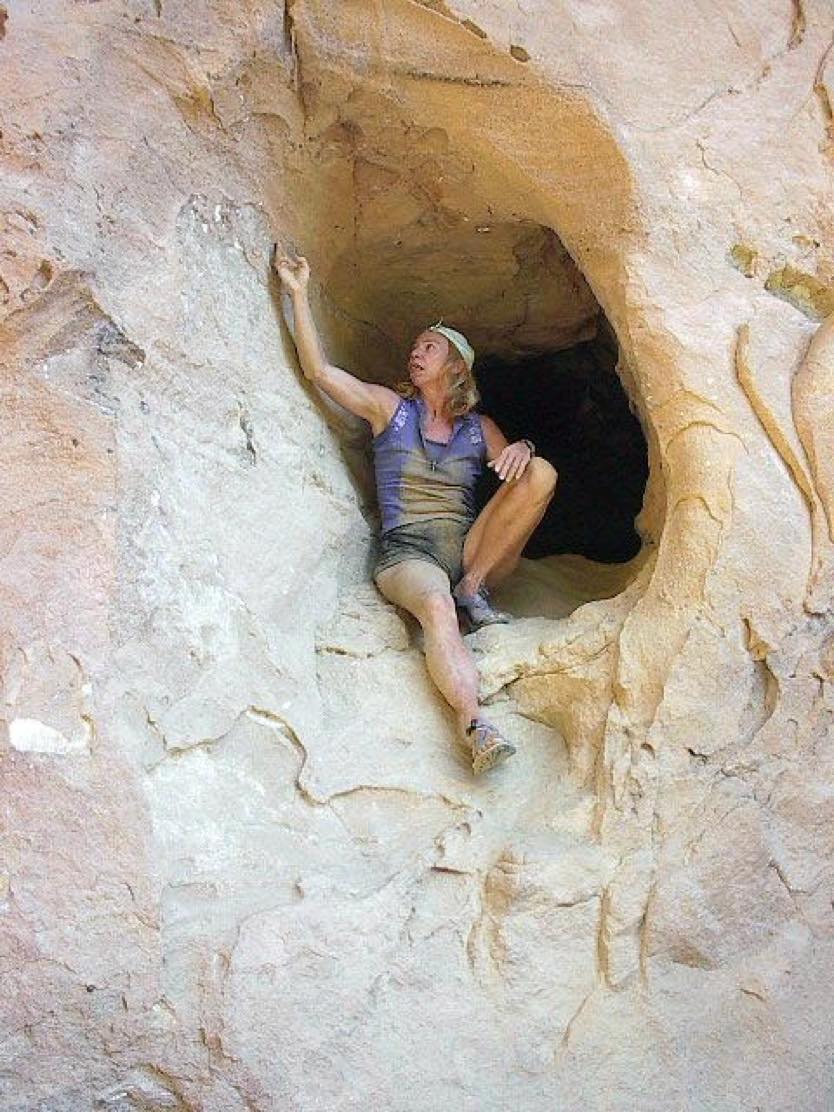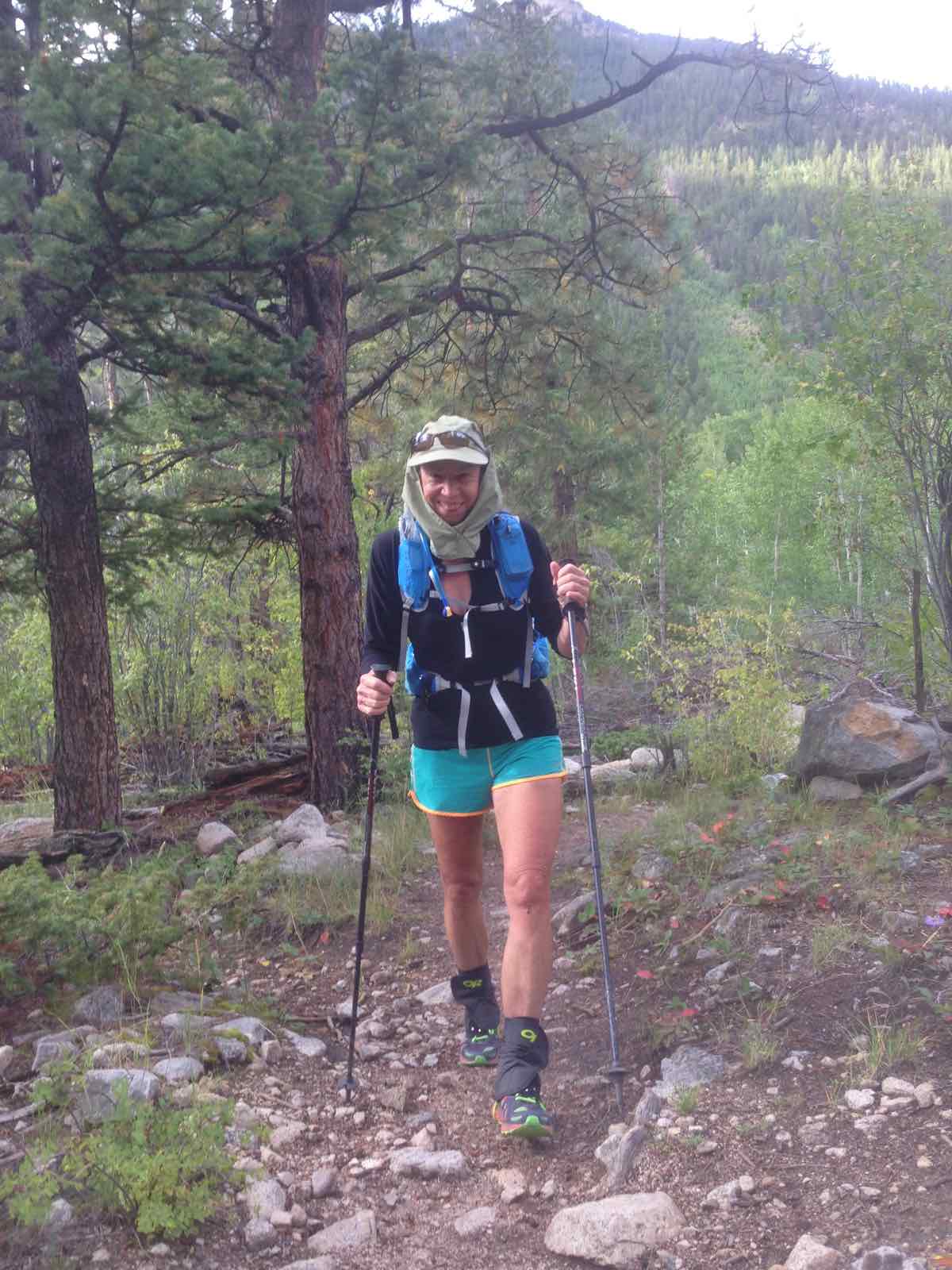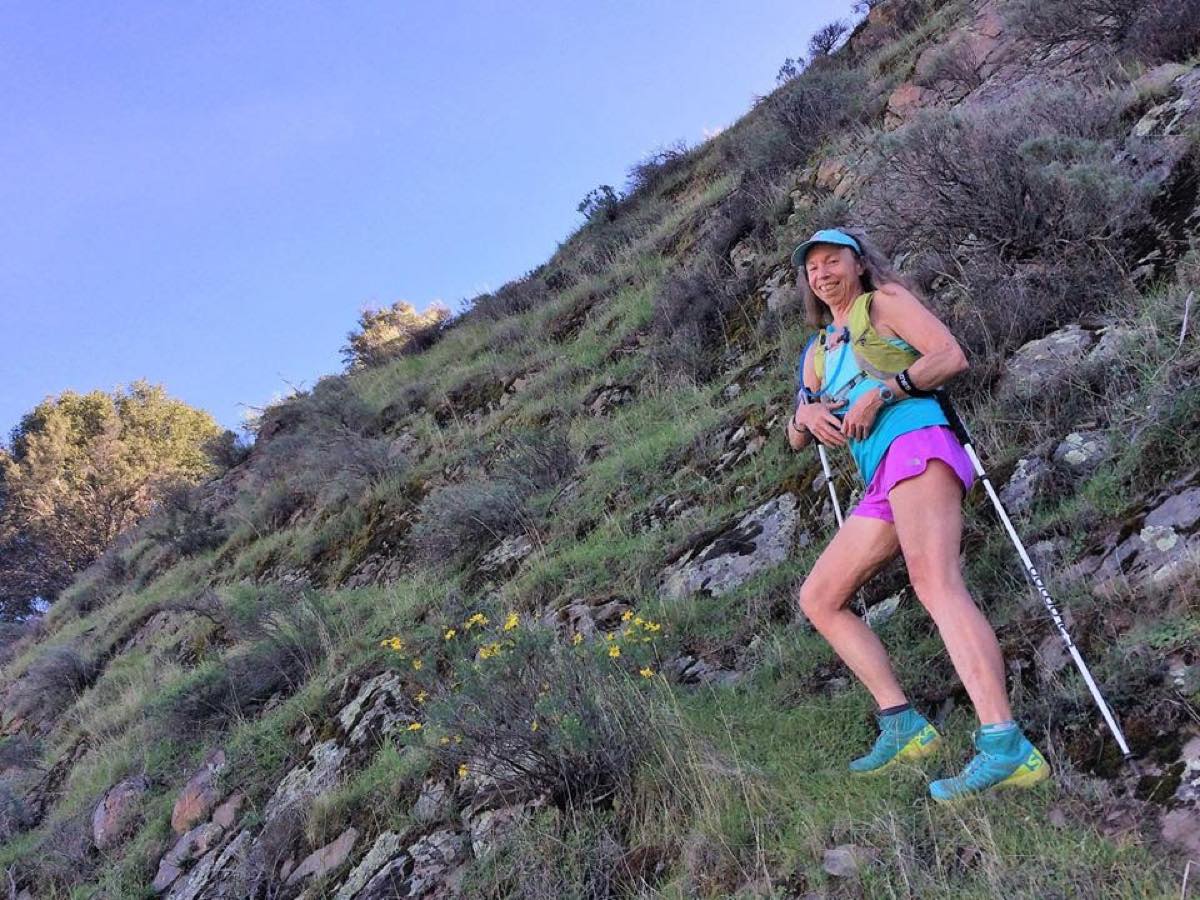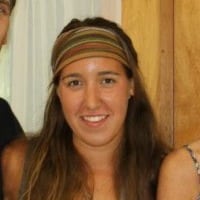Have you ever seen the San Juan Mountains? The high, rugged mountain range in southwest Colorado hosts the legendary Hardrock 100 course. The land is rich with flowers and lush with greenery as far as you can see. It is a breathtakingly beautiful sight to behold.
Well, Nolan’s 14, a 14-peak line of mountains located within Colorado’s Sawatch Range, in the east-central part of the state, are not like that, Ginny LaForme said.
Ginny, a three-time Hardrock finisher and the first woman to attempt the Nolan’s 14 challenge, describes the 14 peaks as thus: “The mountains are bleak; basically huge piles of broken rocks. They are big peaks with big drops between them and down in the valley you can see the whole long string of them laid out in front of you.”
But after her years of exploring in them, after a wealth of experiences alone and with friends, she has found beauty in that difficulty. She summarizes, “They are beautiful in their own right, but are intimidating.”
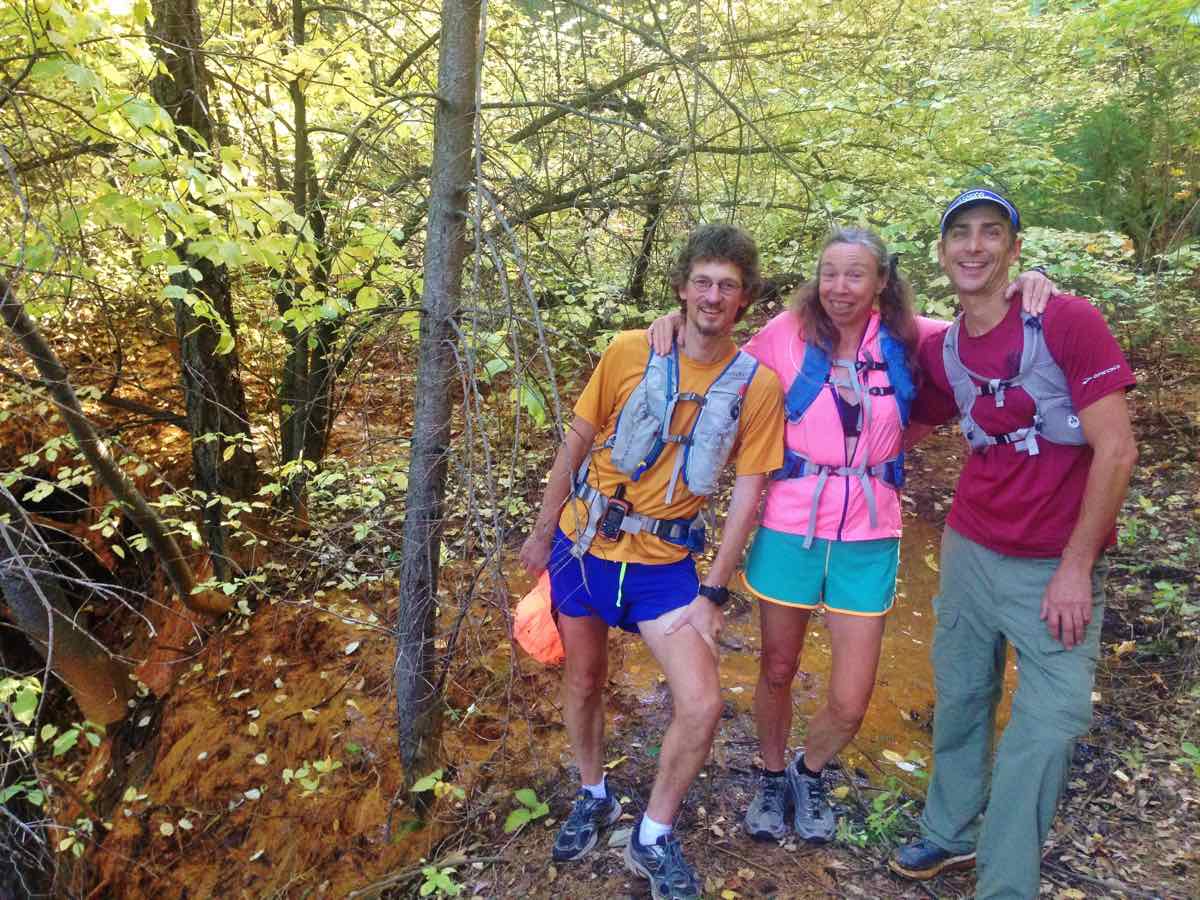
On the Euchre Bar Massacre course in California with Eric Robinson (left) and Joel Tebbutt. Photo: Suzanna Bon
Ginny LaForme and her husband Eric Robinson no longer have an address in California, as they have just traded in both their jobs and house to begin a new journey of traveling around the American West. They may spend a few months visiting Eric’s parents in Oregon before landing in Montana, or New Mexico where Ginny lived for many of her adult years, or in Colorado where they can continue to run in those mountain ranges they enjoy so much. For Ginny, this lifestyle of traveling is not new. As a young girl, she lived in Maryland for several years, Ecuador for three years when her father was a diplomat for the United States Department of State, Hawaii, and then in New Mexico where she raised her two girls.
As a kid, she ran around while exploring and getting dirty. She chased after old farm horses and climbed trees. It wasn’t until she moved to Ecuador when she was about 11 that she got her own horse and spent even more time running, riding, and hiking through the land. Because there was no organized running for girls, she hopped on a track with several college guys and competed in homemade obstacle courses with the kids of the military schools.
“We used to have pretend track and cross-country races,” she said. “I used to drag my girlfriends out and take them to really scary places on long hikes.”
Back in the U.S., she continued to do a lot of horseback riding and in her early twenties dabbled in traditional climbing.
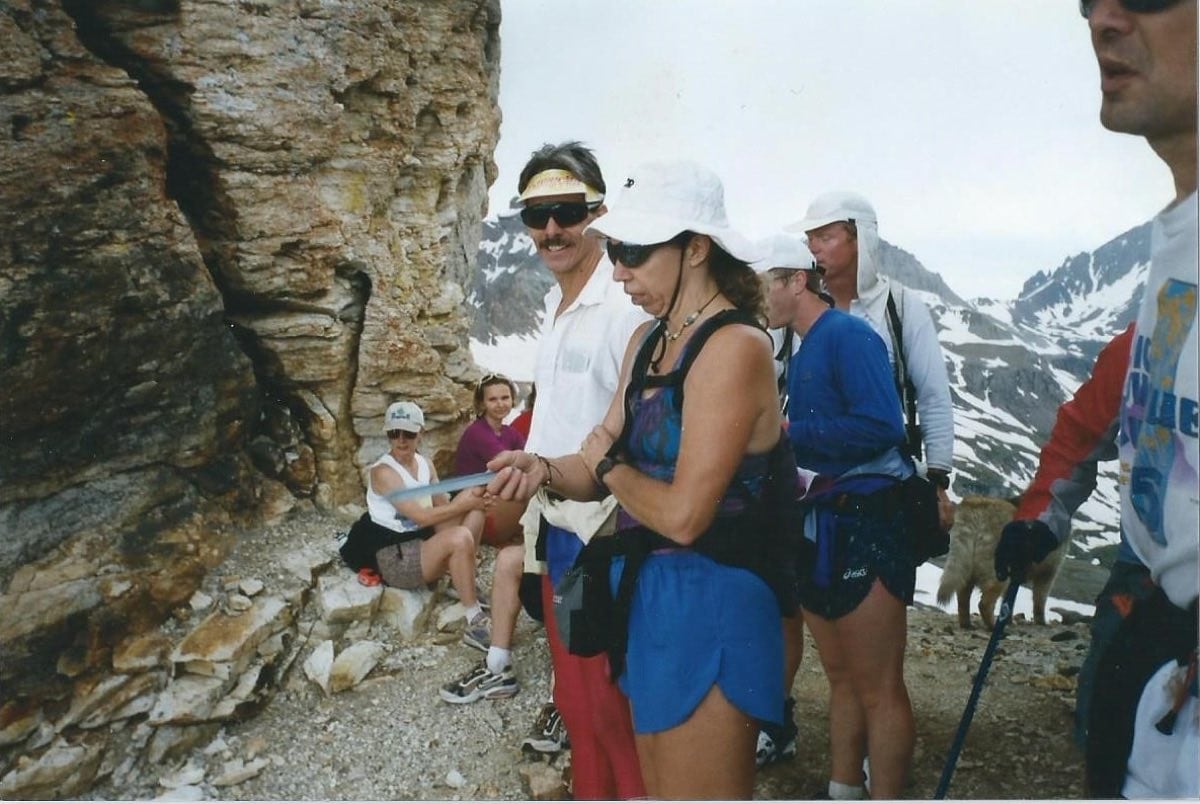
At Virginius Pass in Colorado during the 1998 Hardrock 100 course marking with Bozena Maslanka, Joe Clapper, Scott Mills, and many others. Photo: Charlie Thorn
“There were no gyms, no sport climbing,” she said. “We just went out and found rocks. To get to some of the climbs, we would go up and down with heavy packs.”
Ginny also worked as an Outward Bound counselor, the outdoor-education organization that leads students in hiking, swimming, backpacking, boating, riding, and much more.
At the end of a session, the counselors would put on arduous trail run for anyone who wanted to participate.
“In those days we were so dumb,” she said, laughing. “We thought we were so macho, us instructors. We were anti-hiking boots, so I hiked in these platform flip flops. I ran a 17.5-mile trail run in flip flops because you know, I was cool. I trashed my feet into total mincemeat, but those were the things we liked to do.”
When her daughters were born, the three went on long rides in New Mexico’s backcountry, taking turns as two would ride and the third would run alongside. When her daughters began running track at school, Ginny tagged along and it was around then that she met the group of guys who would eventually connect her with ultrarunning and the Nolan’s 14.
Oh, but there’s another thing about Ginny to know, more backstory which helps explain how she so quickly and seamlessly transitioned into trail ultrarunning’s long and difficult events. Before she turned trail runner, she had been competitively weightlifting for four years.
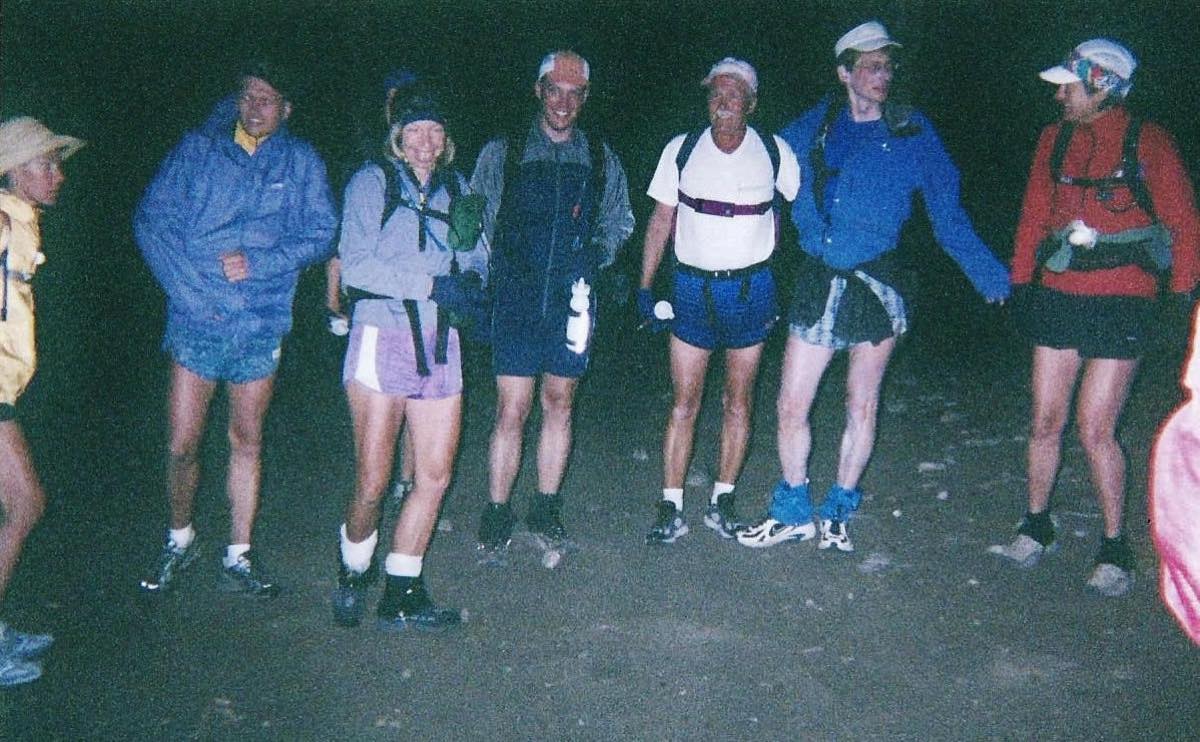
At the the 2002 Nolan’s 14 challenge start in Colorado, with Rickie Redland, John Robinson, Ginny, Tim Erickson, Don Mosel, Eric Robinson, and Betsy Kalmeyer. Photo: Fred Vance
She had stumbled upon a series of trail runs organized by Charlie Thorn, Blake Wood, and a few more of those “Hardrock guys,” as she called them.
In 1994, Ginny was arm deep in trail running as she began competing in these various ‘fat asses,’ put on by her new friends. They were the type of runs where everyone met at a trailhead with a printout of a map. They took off, following a highlighted route, and hoped everyone showed up at the end.
By 1996, she felt ready to take on Hardrock, after hearing so much about it. But she was delayed by a year. She had already signed up to do her second EcoChallenge, an expedition-length adventure race with her team. Out of 75 teams, her team was one of the 12 that finished.
So it was in 1997 that Ginny started her first Hardrock 100. As she will say for every race and challenge she’s done since that first one, “It was going great, until it wasn’t.”
She had been running well all day when, as evening approached, she looked up from the trail to see the next aid station. Bam! She fell flat on her face in a creek, becoming completely drenched in water just as the sun was setting. At the aid station, Ginny was shivering from the cold and the volunteers forced her to stay to warm up.
“I really didn’t know anything, so I just sat there. I got colder and colder and my feet swelled so bad,” she remembered. “I left, but I could barely walk and had to drop.”
Ginny returned in 1998, and ran with Joel Zucker for most of the race. The pair finished in 47 hours and 37 minutes.
“I finished, which was great, but that was the year Joel died,” she said. “So, it was a sad year.”
Joel Zucker passed away from a cerebral hemorrhage two days after his third Hardrock finish.
Ginny lived at about 6,000 feet altitude in New Mexico and on weekends could run up to 12 to 13,000 feet in the mountains. Two weeks before the race, she joined those same Hardrock guys to help mark the Hardrock course in Silverton, Colorado. Though not great with elevation, she said, she was able to camp and stay at higher elevations for days before the race.
“Out of six [tries], I finished three,” Ginny said. “I love Hardrock, everybody loved it.
It was a real family affair in those days.”
The Nolan’s 14 challenge was born in the 1990s, put together by avid Colorado mountaineer Jim Nolan after his friend Fred Vance asked him how many Colorado 14ers, or mountains in excess of 14,000 feet elevation, he thought could be fit into a 100-mile route. Nolan also applied a 60-hour official-finish time limit for anyone taking on the challenge. In 1999, four men gave the line a go, and six men gave it a shot the next year. 2001 saw the first woman take on the Nolan’s 14 challenge: Ginny LaForme.
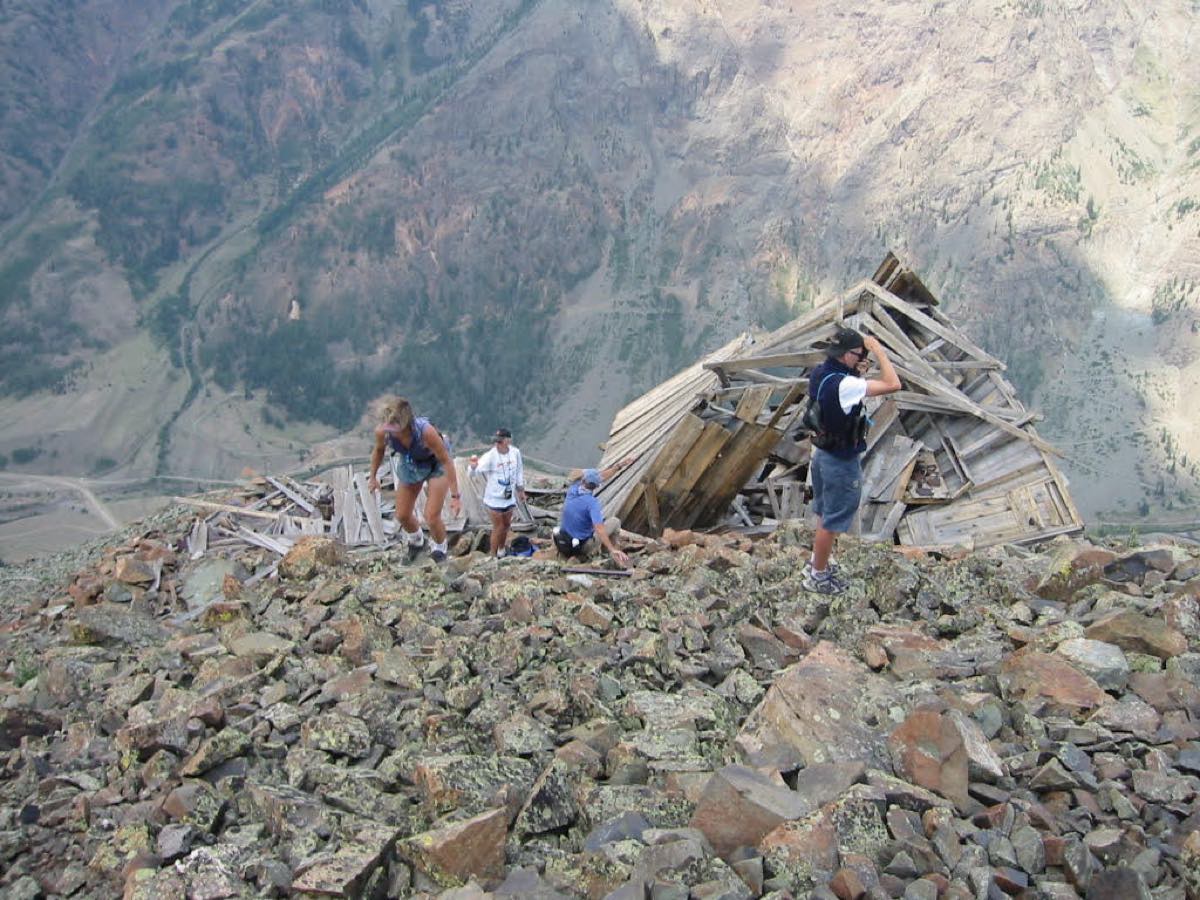
Some after-Hardrock 100 fun in 2001 with Charlie Thorn, Bob Boeder, and John Robinson. Photo: Mike Price
Ginny said that Nolan’s 14 was a race to these guys. It is certainly not a legal race, so she’s talking about a mindset. To these runners, it was a battle from the start, over the near-100 miles of 14 summits over 14,000 feet, to the end 60 hours away. The only rules, which according to Ginny and Matt Mahoney’s website, were more like guidelines: No pacers, no mechanical aid, no leaving the course and returning unless on foot, and the official time limit is 60 hours. Also, you were required to have a crew, and if you didn’t have one Thorn would be your default helper, she said.
In Ginny’s first year, the lot of them ran with Family Radio Service radios so that when a runner reached a peak they would radio it in to someone in the valley for verification. All the radios were tuned to the same channel, so Ginny could hear everyone talking through the entire journey.
At some point in the night, she had gotten herself on a strip of horrendously loose rocks, and was clinging to the face of a mountain, when all of a sudden a burst of orange, blue, and red flame erupted in the sky right in front of her. It was a meteor splitting in two, dripping its flaming contents out around her.
The radios were buzzing, “Did you see that? Did you see that?”
“We all thought we were hallucinating and it was a huge meteor going overhead and it was such a bizarre moment. One of the coolest moments to see, and to see it with all these people on the peaks, too,” she said.
“No one is as fearless, change that to brave,” Eric says about his wife. “And tough is too short of a word. Indomitable. She’s not an easy person to stop. Throw her on the ground, she gets up. Bad route choice? She’ll still find a way forward or around.”
In her first go at the Nolan’s 14, Ginny made it 11 peaks before timing out on the 60-hour limit.
The next year, in 2002, two other women, Betsy Kalmeyer and Rickie Redland, joined Ginny. This was the year Ginny reached 12 peaks in 54 hours and 41 minutes, setting a record at the time for the women. Kalmeyer finished 12 in about four hours behind her and Redland hit nine peaks. Ginny’s record wasn’t broken until 2015 when Anna Frost and Missy Gosney reached all 14 summits in under 60 hours.
In 2003, with the launch of Mahoney’s website, the Nolan’s 14 challenge was getting more attention, which was both good and bad. Sitting in a tiny coffee shop in Leadville, Ginny and her band of ultrarunners were planning out routes for their next Nolan’s trip when local forest rangers approached them.
“They told us if we run Nolan’s, they would fine us and throw us in jail,” Ginny said.
Instead, groups here and there went out to start at different peaks and did their own thing. Ginny, who had finished Hardrock less than a month before, reached nine peaks before stopping this time. Though she had her best Hardrock, her feet had suffered the most.
“My feet were trashed,” she said. “It was really wet at Hardrock and they never really recovered. It was just too much pounding.”
At the end of every Nolan’s, there were unique awards and a celebration dinner at a Chinese restaurant for everyone who was out there.
Ginny and the boys took this challenge as seriously as a race, not just to see who could finish, but who could finish in the least amount of time. They would come out weeks beforehand, or throughout the year, to scout different routes they could use in the challenge.
For that 2002 event, John Robinson and Ginny had discovered a ridge on Missouri Mountain that would make a much more direct pass, but happened to be a very scary, exposed route. Yet, they both, and Eric as well, trekked through it during the challenge.
“There was a thunderstorm coming in when I was on it,” Ginny recalled. “It didn’t hit me, but if it did, I don’t know what would have happened. It is the kind of thing with one slip and you’re dead.”
But it was a faster route, and that’s what they did–find faster routes.
Ginny came back with Eric years later to try Nolan’s 14 one more time, he in 2013 and she in 2014. With a meniscus nearly completely shot, Ginny said, she just wanted to try it one more time to see what she could do. The day was super windy and Ginny was having more difficulty with the GPS Eric had programmed for her than actually running up the peaks.
“Eric had downloaded the points I needed to reach but there was no route, just points. It kept jumping around all over the place. I would reach one point and nope, nothing there,” she said.
It took her an entire night to get between Mounts Columbia and Harvard, a route that should have taken her just a few hours.
“It was so horrible,” she said. “When I finally got up there, it was dawn and already a few guys were there for an early morning ascent and they said, ‘Where did you come from?’ And I said, ‘Oh down that way…’”
She pointed indolently down toward the bottom of the cliff, which prompted the men to ask if she was doing that Nolan’s 14 thing?
“Well… more like Nolan’s 7!” she said and burst into tears.
“It was pitiful,” she said, laughing as she remembered. “I just started crying in front of those guys.”
At the bottom of the peak, she met Eric who had pizza and a sleeping bag waiting for her. After a 30-minute nap, she bounced up, ready to get going, but with how much time she lost earlier, she was only able to finish nine of the peaks again.
“When I’m crewing for Ginny, things are fairly straightforward,” he added. “She might need a few minutes to eat, or maybe a change of shoes. Beyond the mundane things, I try to not to interrupt her focus.”
She hasn’t returned to Hardrock or Nolan’s since that last attempt, which saddens her to think she may never run either again, yet she hopes to return to volunteer. “It is sad that races like Hardrock have lotteries. Hardrock, which Eric and I love… I mean, Hardrock was my life. I would love to be doing Hardrock every year if I could, but it is just so hard to get in that I figured I would let other people in,” she said. “I figured I had already run my best race so I think other people should get in instead of me taking up space.”
And, though she keeps her eyes and ears on the goings on of her mountainous loves, she and Eric have found a few other passions to keep them busy.
For about seven years after their marriage in 2004, their main hobby was keeping afloat their boat docked in California, where Ginny moved to from New Mexico.
When she moved to California, he now had a partner who would “consider running all day and night and so on to be perfectly normal.”
But because Ginny had such a broad sporting background–mountaineering, traditional climbing, skiing, and more–that after he took her around California’s trails, she introduced him to more adventure-like sports.
What the two do now is what Ginny calls “Barkley-esque” runs. She was looking forward to running the Barkley Marathons back in 2000, but at the last minute was unable to leave her family and business.
So, over the years, a group has formed to put on their own fat-ass runs that resemble the bushwhacking, getting lost, find-your-way-back-in-one-piece-type of event.
“There is one near American River on the Western States 100 course, but in parts no one goes. There are crazy steep canyons, you’re bushwhacking through poison oak… it is kind of ‘Blair Witch’ out there, actually,” she described.
She and Eric put on their own challenges in the backcountry, too, which correlates with their other passion, Rogaining. They also like the old-school type of races like Quad Dipsea and the Mt. Baldy Run-to-the-Top and Eric will be running the Tahoe 200 Mile this summer with Ginny crewing and pacing alongside.
In these years where Ginny and Eric do not run Hardrock or Nolan’s 14, they are still watching the new and old faces take a go at them. When Andrew Hamilton added 14er Holy Cross onto the Nolan’s 14 route, called the line “Holy Nolan’s,” and finished it all in some 71 hours, the two were giddy with excitement and slight envy.
“We used to talk about it all the time, Holy Cross. We used to dream about it,” Ginny said. “I used to think I could do it, but it never worked out that way.”
Instead, Ginny has to remember her own accomplishments. Though she never finished all 14 peaks in the Nolan’s 14 challenge, she was the first woman to give it a shot. She helped find the lines that runners now traverse.
When you look at that long line of mountains, their rugged tops, and the vastness of each peak, what is it that brings people to take a crack at the endeavor? What calls them back, like they have beckoned Ginny?
“I would say it is two things,” Ginny said.
- “Just being out there is a huge part of it.”
- “Also because it is like a puzzle. You’re trying to solve it and you know you’re so close. You have all the pieces, but you just have to put them all together in the right spots. It is addictive. It makes you keep coming back until you get it. I really wanted to finish the darn thing. I really wanted to go the whole line.”
Call for Comments (from Meghan)
Have you run, raced, or adventured with Ginny LaForme over the years? Got some good stories from your days out together? Leave a comment to share them. Thanks!
